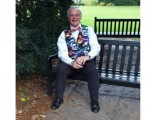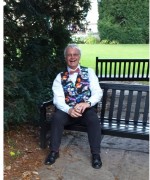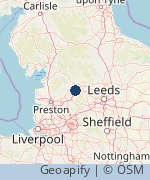Astronomy Talks
Martin Lunn
- Organisation:
- (Select entry)
- Region:
- Yorkshire & Humber
- Notice Period:
- Emergency (maybe less than one week's notice)
- Type:
- Professional
- Fee:
- Paid: 40
- Category:
- Science
- Updated:
- 13th May 2021
- Tagged:
- Astronomy | Yorkshire | Telescopes
A Ramble through the Solar System Take a journey to explore our local star, the Sun, together with eight planets, some which were known to astronomers living thousands of years ago and some that have been discovered in more recent times. We will learn about their moons together with the smaller bodies; the dwarf planets, asteroids, comets and meteors that complete our solar system.
Anglo-Saxon Astronomy The Anglo-Saxon period is often known as the Dark Ages because of the lack of information we have about this period of time, but astronomically it could not be more interesting. During this time there were several major events with global effects. It was a time of diverse views about the heavens in Britain, with Celtic, Greek, Saxon and Viking ideas all competing with each other.
Asteroids, Comets and the Death of the Dinosaurs The Earth is near missed virtually every day by asteroids or lumps or rock, and some small ones do hit the Earth to be seen as spectacular fireballs burning up in the atmosphere. A fifty metre wide comet hit the Earth in 1908 over Siberia, destroying over 80 million trees. Sixty five million years ago a six mile wide asteroid crashed into the Earth and wiped out the dinosaurs. When will the next one be?
Astronomy before the Telescope We are used to hearing of fantastic discoveries made today by astronomers using powerful telescopes. Astronomers from around the world have studied the night sky for thousands of years. Using very simple equipment they made many fantastic discoveries, and some things they got very wrong. This is their story.
Astronomy in the Mediterranean Many great civilisations flourished in the ancient Mediterranean. This talk takes us on an astronomical journey to Egypt, Greece, Mesopotamia and the empires of Byzantium and Arabia. We will also visit Europe during the Renaissance. These were very different civilisations, each with their own interpretation of the night sky. Our modern view of the stars and constellations was shaped in this diverse part of the world, and the study of the oldest of all the sciences is still being undertaken in this region today. This is the story of Astronomy in the Mediterranean.
The Sun and the Northern Lights Our local star, the Sun, dominates everything in the solar system. Worshipped as a god from the earliest of times, at one stage astronomers believed that people lived inside the Sun! Today our knowledge of the Sun has dramatically increased. The Northern Lights, or Aurora Borealis, are caused by flares coming from the Sun and striking the Earth. However, there is a potential danger because if these flares are powerful enough they can overload the very sensitive electronic equipment we rely on today. It has happened in the past and will probably happen again in the future.
John Goodricke and Edward Piggot: The Fathers of Variable Star Astronomy They were an odd couple. John Goodricke was deaf and unable to speak, and Edward Piggot dressed like a dandy, but for a brief moment in time from 1781-1786 they changed the face of astronomy. They discovered stars that changed in brightness and explained why this happened. Goodricke would die before his twenty-second birthday and both their lives could have been written into a soap opera. This is the story of the Fathers of Variable Star Astronomy.
Our Neighbour The Moon Fascinating us since the beginning of time, the Moon was even worshipped as a god in the past, for the protection its night-time light gave to ancient people. At one time, people thought that there were oceans on the moon and that creatures might live there. Today the Moon is a dead world but it is the only place apart from the Earth where people have set foot. Join Martin for a fascinating exploration of the Moon’s history.
Space in the 1960s The space age began on October 4th 1957 when the Soviet Union launched Sputnik; the first man made object to be placed in orbit around the Earth. In the 1960s there was spectacular progress in the exploration of space. Robot space craft explored the Moon and the planets Venus and Mars, and in 1969 Men walked on the Moon. The 1960s saw the beginning of our attempt to cross the final frontier; the conquest of space.
Swept Under the Carpet: the forgotten story of astronomers Edward Crossley and Joseph Gledhill The West Yorkshire town of Halifax was dominated by textile mills in the 19th century. Crossley Carpets made carpets which were exported around the world. What is less well known is that Edward Crossley and his employed assistant astronomer Joseph Gledhill had an observatory with the largest reflecting telescope in England. The two astronomers made massive contributions to the study of astronomy and after their deaths, Crossley’s two big telescopes, the 36 inch Common reflector and the 9.3 inch Cooke refractor, continued to be used in astronomical research.
Telstar On July 10th 1962 Telstar, the world’s first telecommunication satellite was launched. It allowed live pictures to be beamed around the world for the first time. From its first broadcast, which caused a row between France and England, to its early demise in 1963, Telstar’s story was eventful and ground-breaking.
A Very British Meteorite In 1881 a team of workmen on a railway line near Middlesbrough had a close encounter with an intruder from outer space when a meteorite crashed onto the track. That meteorite has now become known as one of the most important on Earth. Join Martin for the curious and entertaining story of the Middlesbrough Meteorite.
The Barwell Meteorite ‘Twas the night before Christmas… and the festive season of 1965 would be like no other when, above the small Leicestershire village of Barwell, a very large turkey size meteorite was about to crash from the sky. This is the amazing story of the Barwell Meteorite.
The Pluto Story Discovered as a planet in 1930 then relegated to a dwarf planet in 2006, Pluto has set astronomers many problems about its size and what kind of planet it really is. It was only in 2015, when the New Horizons space craft flew past Pluto, that we began better to understand this small world at the edge of the solar system. Join Martin to find out all about this small body with a big story.
The Star of Bethlehem It is a star that most people have heard of, yet we know virtually nothing about it. Was it a miracle, was it a myth or was it a genuine astronomical event? This is an astronomer’s view of what the Star of Bethlehem could have been.
Thomas Cooke: Telescope Maker to the Empire Born into a poor family, this is a rags to riches story about a self-taught man who would go on to become one of the greatest telescope makers. He built what was at the time the biggest telescope in the world, made a telescope for Prince Albert and even built steam cars.
Viking Astronomy The Vikings have acquired the reputation of being barbaric marauders. What is less well known is that they were very good astronomers. They produced their own maps of the night sky and have their own myths and legends to describe the sky. In this talk we will go back to the year 912 AD; a very good year to have been an astronomer, and we will look at the night sky as the Vikings would have seen it.
Women Astronomers Few people realise just how much women have contributed to astronomy. Astronomy is seen as a male dominated science, yet over the last 4,000 years women have made many of the most important discoveries in astronomy - only for men to take all the credit! This is the women’s story.
Views: 1349 | Enquiries: 11About Martin Lunn
I studied for my degree in astrophysics with the Open University while working as a guard on British Rail between 1979-82. On being made redundant in 1986 I joined the Civil Service in London.
I was appointed Curator of Astronomy at the Yorkshire Museum in York in 1989, a post I held until I took early retirement in 2011. As a public astronomer I promoted astronomy at the York Observatory, which is part of the museum, including arranging open viewing evenings and special events. At the same time I undertook research into astronomy.
It was during my time at the museum that I became (apparently!) a leading authority on one of the world’s greatest telescope makers, Thomas Cooke of York, who amongst other achievements made a telescope for Prince Albert in 1860 and constructed the Newal Refractor, at the time the largest telescope in the world. In addition I also became a noted authority on the 18th century astronomer John Goodricke, who was deaf and without speech. He lived in York and during his brief life (he died before he was 22 years old) helped change the way astronomers look at the stars. The third topic for my work was the Middlesbrough Meteorite, which is used as a text book example of an oriented meteorite.
I worked with North Yorkshire Education Authority and the Yorkshire Museum to produce an event called ‘Earth and Space’ which ran each autumn for six years from 1992. The event was a series of interactive workshops running over a six week period, during which 6,000 children would participate each year.
In 1998 I was presented with an MBE for services to astronomy and education.
Until 2020 when I took retirement due to Covid I spent my time working in schools, usually primary, with my Stardome Planetarium. During the last seventeen years I have taken the Stardome into over 1200 schools. I also have presented many ‘Star Parties’; after school events where I take parents and children outside to look at the night sky.
I present talks to astronomy societies, and to various institutions such as the Women’s Institute, Probus Clubs and historical societies, I also run our local astronomy group, the Earby Astronomical Society. Earby is situated in Lancashire close to the Yorkshire border near Skipton. We are probably one of the few societies to hold our meetings in a church. In 2017 I began presenting astronomy talks on cruise ships.
I have made a series of short films on Youtube about the planets which can be seen on the ‘Hitch Hikers Guide to the Cosmos’ page. I also present a weekly astronomy show on Drystone radio www.drystoneradio.com which is a community radio station covering the Yorkshire Dales, with internet listeners around the world. I present regular blogs and podcasts on Yorkshire Astronomy and I also write a regular monthly astronomy column for the Craven Herald newspaper which covers the Yorkshire Dales.
Other Talks on SpeakerNet by Martin Lunn
Send a message to the speaker
If you are interested in this talk and wish to contact the speaker, please complete the following form:


